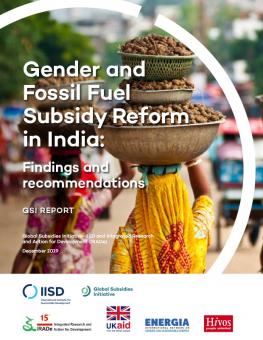
Gender and Fossil Fuel Subsidy Reform in India: Findings and recommendations
The report examines the impacts of India’s subsidies to cooking gas—and their reform—from a gender perspective. It explores how liquified petroleum gas (LPG) subsidy policies and their reform affect women and girls in low-income households.
-
#India’s schemes to promote clean cooking are improving #energy access for poor women, but around half of the women surveyed are being left behind because they continue to cook with biomass.
-
Current LPG subsidies are inefficient and untargeted: among surveyed households, only 48% receiving connection subsidies were among the poorest 40% of households and 48% of consumption subsidy recipients did not hold below the poverty line cards.
-
#India is reviewing its #energy subsidies—this is an opportunity to target policies so that more poor households benefit and adopt a more holistic strategy that promotes non-fossil-fuel cooking technologies.
Key Messages
- The report examines the impacts of India’s subsidies to cooking gas—and their reform—from a gender perspective.
- On average, when cooking with liquified petroleum gas (LPG) rather than biomass, women saved about one hour per day due to reduced cooking and cleaning times.
- The report recommends reviewing subsidy targeting policies so that more poor households benefit from ongoing LPG subsidies because its findings show current LPG subsidies to be inefficient and untargeted.
The report examines the impacts of India’s subsidies to cooking gas—and their reform—from a gender perspective. The research explores how liquified petroleum gas (LPG) subsidy policies and their reform affect women and girls in low-income households. These questions were answered via a survey of over 800 households, examining of secondary data, and focus group discussions.
This research found that India’s schemes to promote clean cooking are improving energy access for poor women. However, around half of the women surveyed are being left behind because they are not using LPG and continue to cook with biomass. Women saved on average about one hour per day due to reduced cooking and cleaning times when cooking with LPG rather than biomass. These women also benefited from a reduction in exposure to harmful indoor air pollution and drudgery.
According to the research, current LPG subsidies are inefficient and untargeted. India has two broad LPG subsidy types: connection subsidies called PMUY that are directed to women’s bank accounts, and consumption subsidies called PAHAL. Among surveyed households, only 48 per cent of PMUY beneficiaries were among the poorest 40 per cent of households. Similarly, under surveyed PAHAL beneficiaries, 48 per cent did not hold below the poverty line (BPL) cards.
India is reviewing its energy subsidies and aims to increase energy access and women’s empowerment. These reforms present an opportunity for policy-makers to deliver and target policies that cluster gender and energy access benefits toward the poor. The report recommends reviewing subsidy targeting policies, so more poor households benefit from ongoing LPG subsidies. It also suggests undertaking subsidy reform cautiously to avoid negative energy access impacts. The report recommends a more holistic strategy for clean cooking in India that promotes the development of non-fossil fuel-cooking technologies, including cooking on electricity.
You might also be interested in
Gender and Fossil Fuel Subsidy Reform in Nigeria: Findings and recommendations
The report examines from a gender perspective the impact of kerosene subsidies and their reform in Nigeria, finding that kerosene subsidies did not work for poor women.
Gender and Fossil Fuel Subsidy Reform in Bangladesh: Findings and recommendations
The report examines from a gender perspective the impact of kerosene subsidies and their reform in Bangladesh. The report advocates that kerosene subsidy reform needs to be handled with care.
Part 1 – How Can India’s Energy Sector Recover Sustainably from COVID-19?
From IISD and CEEW, Part 1 of a three-part commentary series takes a deep dive into how India’s energy sector is coping with the impacts of COVID-19 and what this means for the sustainable energy transition.
Mapping India's Energy Subsidies 2020: Fossil fuels, renewables and electric vehicles
How have India’s energy subsidy policies changed? What have been the most significant developments in India’s dynamic energy policy environment? And is public support aligned with India’s desired energy future?